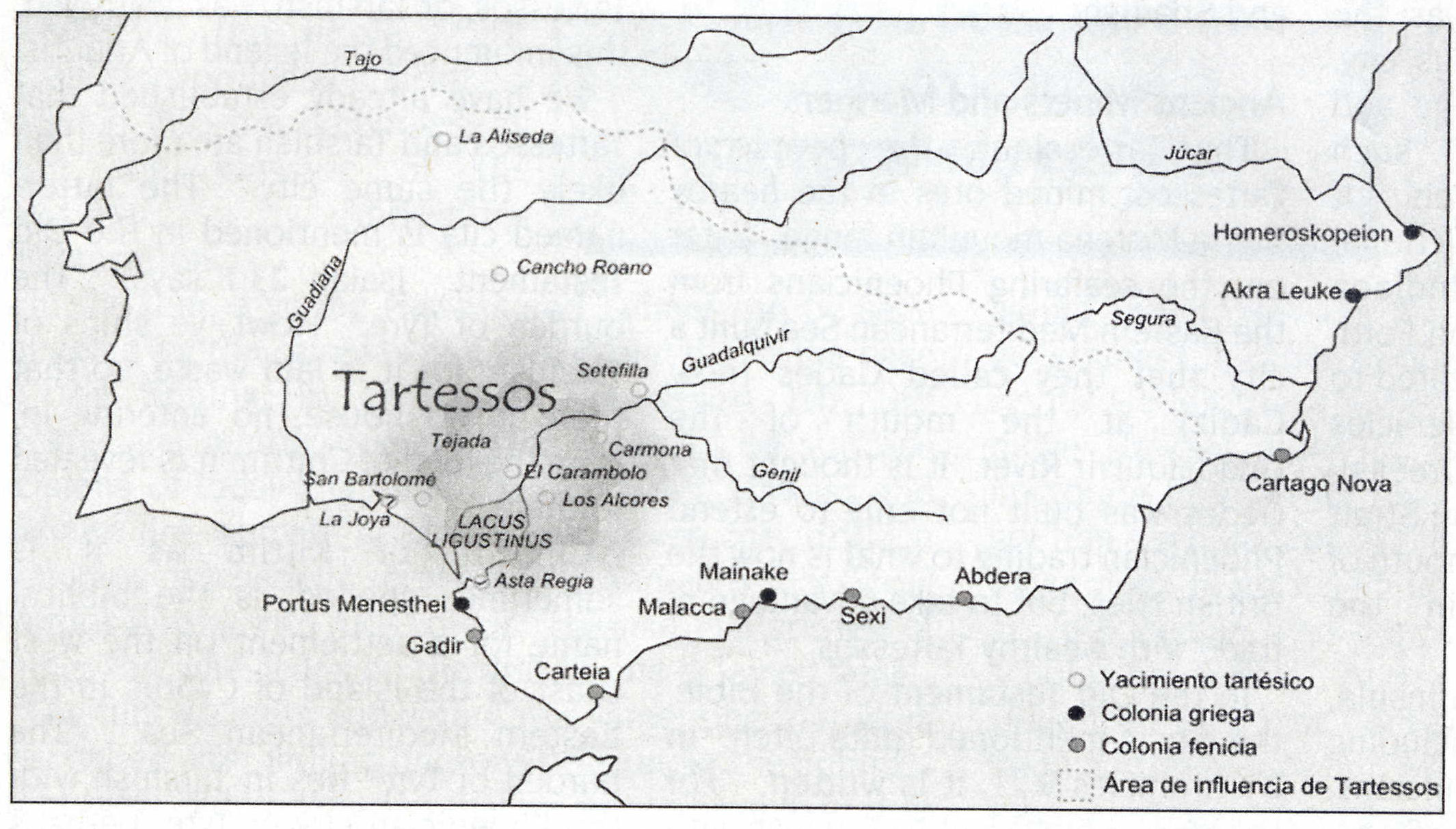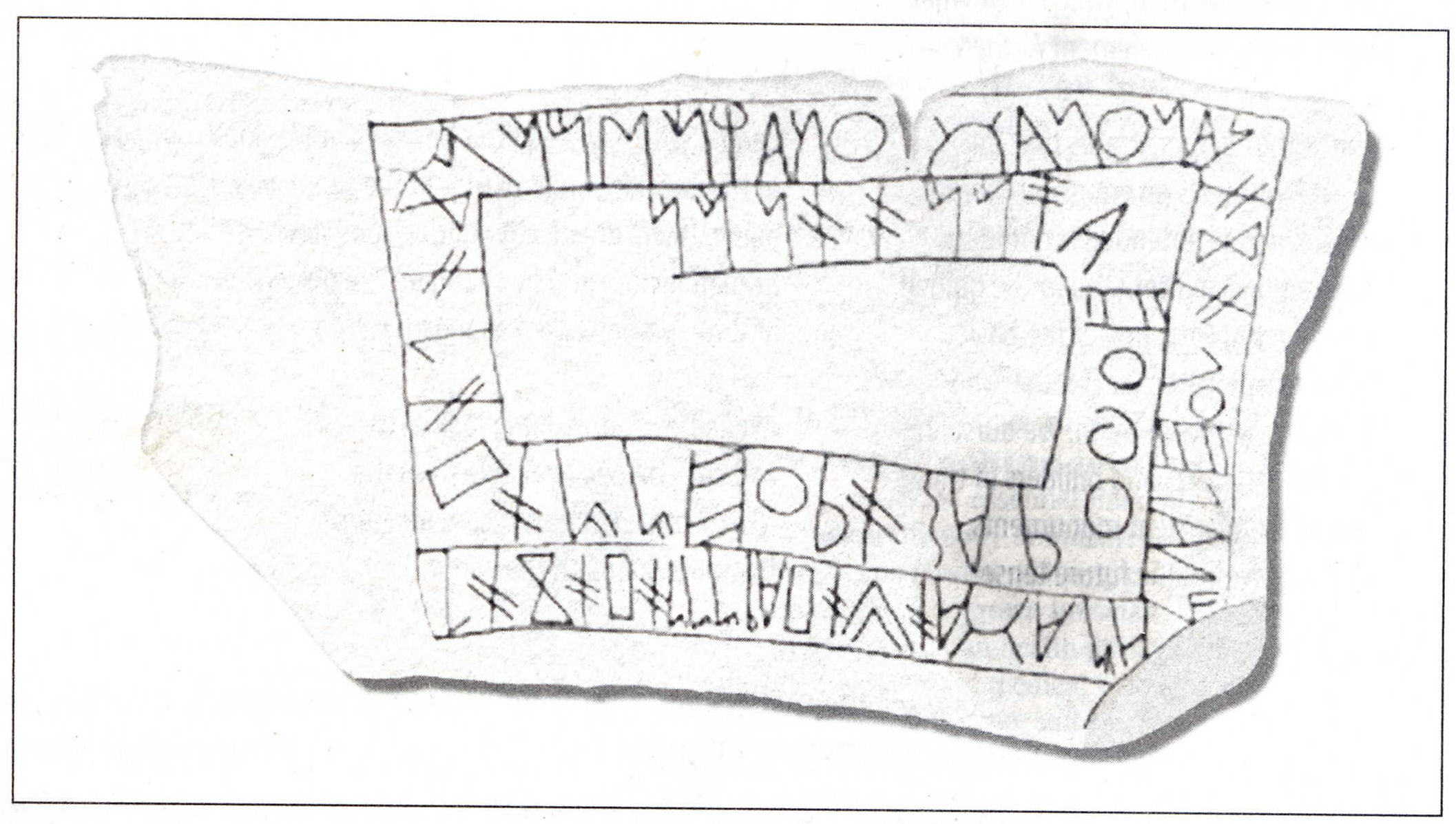

Advancing the Revelation of Truth
TARSHISH
The following copyright article is written by Steven A Arts, an author based in Iowa U.S.A. It is taken from NEXUS magazine vol.23 No.1 with the authors permission.

Southern Spain showing the Tartessos cultural area. [Source: Wikipedia]
A LOST CITY IN SPAIN ?
It has Been speculated for well over 100 years that there is a still lost city in the south western part of of Spain, on or near the Guadalquivir River. That lost city is known by several names. The Romans knew it as Tartessus, and the ancient Hebrews of the Bible referred to as Tarshish.
There is nothing quite so invigorating and interesting as the story of a long lost mysterious city. Stories from both archaeology and fiction are replete with such wondrous tales of exploration. It brings to mind more modern fictional stories of archaeological Indiana Jones played by Harrison Ford.
Tartessos was said to be located to the west of the Pillars of Heracles (Hercules to the ancient Greeks), beyond what is now called the straight of Gibraltar and close to the mouth of the Guadalquivir River in the Southwest of Spain.
This land, the Iberian Peninsula, has had many conquerors, including the Celts, Tartessians, Phoenicians, Carthaginia, Visigoths, Moors, and the Spanish and Portuguese themselves.
A German archaeologist by the name of Adolf Schulten became interested in Tartessos and was convinced that it and the legendry lost city of Atlantis were one and the same place. He conducted an expedition in the early 1920s to the Guadalquivir River to try to find Tartessos. Schulten was an historian and archaeologist from Elberfeld, Germany in the Rhine region. He even wrote a book about Tartessos, which is only available in German and Spanish.
ANCIENT MINERS AND MARINERS
The Tartessians, the people of Tartessos, mined ores in the nearby Sierra Morena mountain range. Later on, the seafaring Phoenicians from the Eastern Mediterranean Sea built a city which they called Gades (now Cadiz) at the mouth of the Guadalquivir River. It is thought that Gades was built not only to extend Phoenician trading to what is now the British Isles, but to take advantage of trade with wealthy Tartessos.
In the Old Testament of The Bible, the city is mentioned quite often. In 2Chronicles 9:21, it is written:
For the king’s ships went to Tarshish with the servants of Huram, every three years once came the ships of Tarshish bringing gold and silver, ivory, and apes and peacocks.
The name Huram refers to the world renowned King Hiram of Tyre. Most readers of the Bible would think of Hiram as a great Phoenician king, but some scholars thinks that Hiram was the king’s title, not a personal name. Tyre was a city in Phoenicia, now modern Lebanon.
Needless to say, Schulten never did find the lost city of Tartessos. It is completely possible that when Tartessos or Tarshish was destroyed, this influenced the legend of Atlantis.
We have already established that Tartessos and Tarshish are more than likely the same city. The latter named city is mentioned in the Old Testament. Isaiah 23:1 says:
The burden of Tyre. Howl ye ships of Tarshish, for it is laid waste, so that there is no house, no entering in, from the land of Chittim it is revealed to them.
Chittim, or Kittim as it is sometimes spelled, is the Biblical name for a settlement on the West coast of the island of Cyprus in the Eastern Mediterranian Sea. ‘The burden of Tyre’ ties in Tarshish with the Phoenician city of Tyre, perhaps as financial or trading partners.
Genesis 10:4 gives us a Biblical familial perspective on Tarshish or Tartessos:
And the sons of Javan, Elishah, and Tarshish, Kittim and Dodanim’
This somehow ties in Tarshish with the Cypriot Greeks. Javan refers to Caucasians or Europeans. So Tarshish might be located somewhere in Europe, such as in South western Spain.
As to whatever or wherever Tarshish was, 1Kings 10:22 says:
For the king had at sea a navy of Tarshish with the navy of Hiram, once three years came the navy of Tharshish, bringing gold, and silver, ivory, and apes, and peacocks.’.
These are perhaps references to Tarshish’s Western Mediteranian Sea location, close to West Africa. Tharshish is merely a variant spelling of Tarshish.
That the Phoenician and Carthaginian ships could travel far from sight of land has been proven. Cartheginian coins have been found far from the shores of Africa and Europe in the Azores islands——proof that ancient mariners were not restricted merely to knowing coastal areas, as has long been thought.
The scientific community as a whole has long underestimated the technological achievements of ancient civilisations.
There is further mention of silver in the Bible in Jeremiah 10:9:
Silver spread into plates is brought from Tarshish, and gold from Uphaz, the work of the workman, and of the hands of the founder, blue and purple is their clothing, they are all the work of cunning men.
In 2Chronicles 20:36 is this mention:
And he joined himself with him to make ships to go to Tarshish, and they made the ships at Ezion geber.
Ezion–Geber [Eziongeber] was an ancient city located on the Gulf of Aqabar, which is itself an arm of the Red Sea. Look at a map of that area, ships built there would have had to be transported to the Mediteranian Sea over land through ancient Israel, or to have circumnavigated the entire continent of Africa, for the suez Canal was far into the future. Perhaps that is why the ships of Tarshish, at least on their maiden voyages
voyages, took so long to reach her European and West African ports of call. There is literary proof that the Phoenicians sailed from the same Ezion-Geber, around Africa, through the Mediterranean Sea and back to Phoenicia in ancient times.
In 2Chronicles 20-37 it is written:
Then Eliezer the son of Dodovah of Mareshah prophesied against Jehoshephat saying: Because thou has joined thyself with Ahaziah, The Lord hath broken thy works. And the ships were broken that they were not able to go to Tarshish.
Again this is an allusion to a naval disaster of some sort for Tarshish.
The area where Tarshish was supposedly located near the mouth of the Guadalquivir River in Southwestern Spain, has a long and ancient history. A late Bronze Age hoard was discovered in 1923 off the coast of the city of Huelva. An Irish lunate spearhead and some Cypriot finds were among many discoveries.
That there were Irish finds in the area were not so unexpected. There is an ancient tradition in Ireland that the island was invaded and settled by a tribe from Northern Spain known as the Milesians. In the area of Northern Brittany lived a Celtic tribe called the Oestrymians. This tribe was supposedly associated with the Tartessians and was said to have helped those people mine the Isles of Scilly, off the tip of Cornwall. That Celtic tribes as far apart as the Milesians of Northern Spain and then Ireland and the Oestrymians of Brittany traded with one another is not surprising. It was often thought that the Phoenicians themselves mined the Isles of Scilly. However, the latest information tells us that the Tartessians with the help of the local Oestrymians actually mined the islands for tin. It makes sense because, in historically recorded times, none other than Julius Caesar himself recorded how the Veneti, a Gaulish Celtic tribe in the same area of Brittany were accomplished mariners. It is perhaps possible that the Oestrymians and the Veneti were one and the same tribe or closely related to one another.
There is a direct tie-in between the Tartessians and the Celtic tribes of the Iberian peninsular itself. That there were so called Celtic Iberian tribes in what is now Spain and Portugal has long been known.
CELTIC IBERIAN DEITIES
Bits and pieces of artefacts relating to various Celtic deities have been found. One such deity, Endovelicus, was supposedly worshipped in ancient times over a large area of what is now Southwestern Spain and Portugal. An oracular deity, Endovelicus was associated with the underworld or otherworld, and several temples and sanctuaries were dedicated to him, including ones at Sao Miguel da Mota in Alentejo and in Alandroal in what is now Portugal. Endovelicus was also associated with the boar, which was an extremely important animal to the ancient Celts and figures prominently in surviving Celtic tales. Laurel and Pine were also linked with this god, which represented immortality.
It has been speculated that Endovelicus was connected with several other Celtic deities such as Succelos [Dis Pater] and Cernunnos, the latter being a horned or antlered god of fertility and plenty.
The Greek geographer-historian Strabo in reporting on the travels of the lyric poet Anacreon, linked Tartessos with the popular demigod Heracles. The first king of Tartessos was supposed to have been named Habis, and he made laws to unite the people. Tartessians also had close ties with Mainake, the lost Greek colony in Southern Iberia.
RECENT EXPEDITIONS
There is a large marshy area near the mouth of
the Guadalquivir called Doňana
National Park, where the original site of the city of Tartessos might be found.
During the Roman occupation period there was a large lake there, called Lacus
Ligustinus. It was originally thought to be far too marshy to have ever been
inhabited by humans. That view is changing.
The Tatessian Fonte Velha inscription [Bensafrim, Lagos, Portugal]. [Source: Wikipedia]
Reports that the site of Tartessos might be in these marshes inspired two expeditions to the area in July 2006 and in August-September 2009, the former lasted only five days and the latter went on for five weeks [see http://tinyurl.com/oy8zmb5 for more details] Researchers found pottery sherds from the Neolithic Copper and Bronze ages as well as from the seventh to 13th centuries CE during the time of the Muslim occupation of Southern Spain. Two clay statuettes from the Roman period were found as well.
Geological drillings to depths up to 18metres showed a sandy layer within the clay subsoil. The scientists said that this showed that an event such as a storm flood or a tsunami had occurred during the third millennium BCE.
An aerial survey of the park showed rectangular and circular forms that might be part of ancient Tartessos. Rocks used for building were found there during the July 2006 expedition. One day we may find out if Tartessos really did exist and where it is located. We may never know, however if the destruction of Tartessos was the template for the fascinating legend of the lost city and continent of Atlantis.